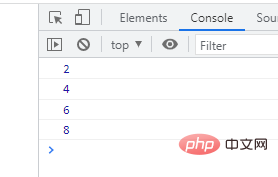JS loop learning: break out of loop statements break and continue
In the previous article, we took you to learn several loop control structures in JS (while and do-while loops, for loop), let’s talk about jumping out Loop statements break and continue, I hope it will be helpful to everyone!

We know from the previous study of loops that by default the loop will automatically exit the loop when the expression result is false, otherwise the loop will continue forever. In some cases, we do not need to wait for the loop to exit automatically, but can actively exit the loop. JavaScript provides two statements, break and continue, to exit the loop and exit (skip) the current loop.
1. Continue statement
The continue statement is used to skip this loop and execute the next loop. When a continue statement is encountered, the program will immediately re-test the conditional expression. If the expression result is true, the next loop will start. If the expression result is false, the loop will exit.
[Example 1] Use the continue statement to jump out of the for loop:
<script type="text/javascript">
for (var i = 1; i < 10; i++) {
if(i % 2 != 0) {
continue;
}
console.log(i);
}
</script>Analysis:
for (var i = 0; i < ; 10; i ){}The statement can be used to loop through all numbers between 1 and 10if(i % 2 != 0)The statement is used to determine whether the value of i is divisible by 2. If it cannot be divisible, if the value in()is true, thecontinue;statement will be executed.In the loop body, use the
if(i % 2 == 0)statement to determine if the value ofican be divided by 2 Just use "console.log(i);" to output; if the value oficannot be divided evenly by 2, thecontinue;statement will be triggered to jump out of this loop ( No output), execute the next cycle.
Output result:

2. break statement
# The ##break statement is used to jump out of the current syntax structure. It can terminate the code of the loop body and jump out of the current loop immediately, executing the code after the loop (if any). The difference between break and continue is that the continue statement only ends the current loop, while the break statement terminates the execution of the entire loop. Use the code in Example 1 above and replace continue; with break;. What will be output?
<script type="text/javascript">
for (var i = 1; i < 10; i++) {
if(i % 2 != 0) {
break;
}
console.log(i);
}
</script>Nothing is output. Why is this happening? Let’s analyze it:
At the beginning of the forx loop,i=1, is 1 less than 10? Of course, then start executing the if(i % 2 != 0) statement in the loop body;
() is true, then the "break;" statement in the if is executed, jumping out of the entire loop directly, and there is no chance to execute "console" .log(i);" statement.
break and continueare only valid for the current cycle. If we have nested loops, we have to be careful. Let's take a look at the following example:
for (let i = 0; i < 5; i++) {
if (i % 2 == 0) continue;
for (let j = 0; j < 5; j++) {
if (j == 2) break;
console.log(`i = ${i}, j = ${j}`);
}
}
4. JavaScript tag
From JavaScript 1.2 Initially, you can use labels in conjunction with break and continue to control program execution more precisely. The tag in JavaScript is different from the tag in HTML. The tag in JavaScript is an identifier (similar to a variable name), followed by a colon:. JavaScript tags can be declared before any statement or code block, and used in conjunction with break or continue to jump out of a specific loop. For example, when multiple loops are nested, simply using break can only jump out of the current loop, but not the outer loop. If you use break with labels, you can break out of multiple levels of loops at once. The sample code is as follows:<script type="text/javascript">
document.write("开始循环!<br /> ");
outerloop: // 定义一个标签
for (var i = 0; i < 5; i++) {
document.write("外层循环: " + i + "<br />");
innerloop: // 定义一个标签
for (var j = 0; j < 5; j++) {
if (j > 3 ) break ; // 跳出内层循环
if (i == 2) break innerloop; // 跳出内层讯息
if (i == 4) break outerloop; // 跳出外层循环
document.write("内层循环: " + j + " <br />");
}
}
document.write("循环结束!<br /> ");
</script>
javascript advanced tutorial]
The above is the detailed content of JS loop learning: break out of loop statements break and continue. For more information, please follow other related articles on the PHP Chinese website!

Hot AI Tools

Undresser.AI Undress
AI-powered app for creating realistic nude photos

AI Clothes Remover
Online AI tool for removing clothes from photos.

Undress AI Tool
Undress images for free

Clothoff.io
AI clothes remover

Video Face Swap
Swap faces in any video effortlessly with our completely free AI face swap tool!

Hot Article

Hot Tools

Notepad++7.3.1
Easy-to-use and free code editor

SublimeText3 Chinese version
Chinese version, very easy to use

Zend Studio 13.0.1
Powerful PHP integrated development environment

Dreamweaver CS6
Visual web development tools

SublimeText3 Mac version
God-level code editing software (SublimeText3)

Hot Topics
 How to implement an online speech recognition system using WebSocket and JavaScript
Dec 17, 2023 pm 02:54 PM
How to implement an online speech recognition system using WebSocket and JavaScript
Dec 17, 2023 pm 02:54 PM
How to use WebSocket and JavaScript to implement an online speech recognition system Introduction: With the continuous development of technology, speech recognition technology has become an important part of the field of artificial intelligence. The online speech recognition system based on WebSocket and JavaScript has the characteristics of low latency, real-time and cross-platform, and has become a widely used solution. This article will introduce how to use WebSocket and JavaScript to implement an online speech recognition system.
 WebSocket and JavaScript: key technologies for implementing real-time monitoring systems
Dec 17, 2023 pm 05:30 PM
WebSocket and JavaScript: key technologies for implementing real-time monitoring systems
Dec 17, 2023 pm 05:30 PM
WebSocket and JavaScript: Key technologies for realizing real-time monitoring systems Introduction: With the rapid development of Internet technology, real-time monitoring systems have been widely used in various fields. One of the key technologies to achieve real-time monitoring is the combination of WebSocket and JavaScript. This article will introduce the application of WebSocket and JavaScript in real-time monitoring systems, give code examples, and explain their implementation principles in detail. 1. WebSocket technology
 How to use JavaScript and WebSocket to implement a real-time online ordering system
Dec 17, 2023 pm 12:09 PM
How to use JavaScript and WebSocket to implement a real-time online ordering system
Dec 17, 2023 pm 12:09 PM
Introduction to how to use JavaScript and WebSocket to implement a real-time online ordering system: With the popularity of the Internet and the advancement of technology, more and more restaurants have begun to provide online ordering services. In order to implement a real-time online ordering system, we can use JavaScript and WebSocket technology. WebSocket is a full-duplex communication protocol based on the TCP protocol, which can realize real-time two-way communication between the client and the server. In the real-time online ordering system, when the user selects dishes and places an order
 How to implement an online reservation system using WebSocket and JavaScript
Dec 17, 2023 am 09:39 AM
How to implement an online reservation system using WebSocket and JavaScript
Dec 17, 2023 am 09:39 AM
How to use WebSocket and JavaScript to implement an online reservation system. In today's digital era, more and more businesses and services need to provide online reservation functions. It is crucial to implement an efficient and real-time online reservation system. This article will introduce how to use WebSocket and JavaScript to implement an online reservation system, and provide specific code examples. 1. What is WebSocket? WebSocket is a full-duplex method on a single TCP connection.
 JavaScript and WebSocket: Building an efficient real-time weather forecasting system
Dec 17, 2023 pm 05:13 PM
JavaScript and WebSocket: Building an efficient real-time weather forecasting system
Dec 17, 2023 pm 05:13 PM
JavaScript and WebSocket: Building an efficient real-time weather forecast system Introduction: Today, the accuracy of weather forecasts is of great significance to daily life and decision-making. As technology develops, we can provide more accurate and reliable weather forecasts by obtaining weather data in real time. In this article, we will learn how to use JavaScript and WebSocket technology to build an efficient real-time weather forecast system. This article will demonstrate the implementation process through specific code examples. We
 Simple JavaScript Tutorial: How to Get HTTP Status Code
Jan 05, 2024 pm 06:08 PM
Simple JavaScript Tutorial: How to Get HTTP Status Code
Jan 05, 2024 pm 06:08 PM
JavaScript tutorial: How to get HTTP status code, specific code examples are required. Preface: In web development, data interaction with the server is often involved. When communicating with the server, we often need to obtain the returned HTTP status code to determine whether the operation is successful, and perform corresponding processing based on different status codes. This article will teach you how to use JavaScript to obtain HTTP status codes and provide some practical code examples. Using XMLHttpRequest
 How to use insertBefore in javascript
Nov 24, 2023 am 11:56 AM
How to use insertBefore in javascript
Nov 24, 2023 am 11:56 AM
Usage: In JavaScript, the insertBefore() method is used to insert a new node in the DOM tree. This method requires two parameters: the new node to be inserted and the reference node (that is, the node where the new node will be inserted).
 JavaScript and WebSocket: Building an efficient real-time image processing system
Dec 17, 2023 am 08:41 AM
JavaScript and WebSocket: Building an efficient real-time image processing system
Dec 17, 2023 am 08:41 AM
JavaScript is a programming language widely used in web development, while WebSocket is a network protocol used for real-time communication. Combining the powerful functions of the two, we can create an efficient real-time image processing system. This article will introduce how to implement this system using JavaScript and WebSocket, and provide specific code examples. First, we need to clarify the requirements and goals of the real-time image processing system. Suppose we have a camera device that can collect real-time image data






